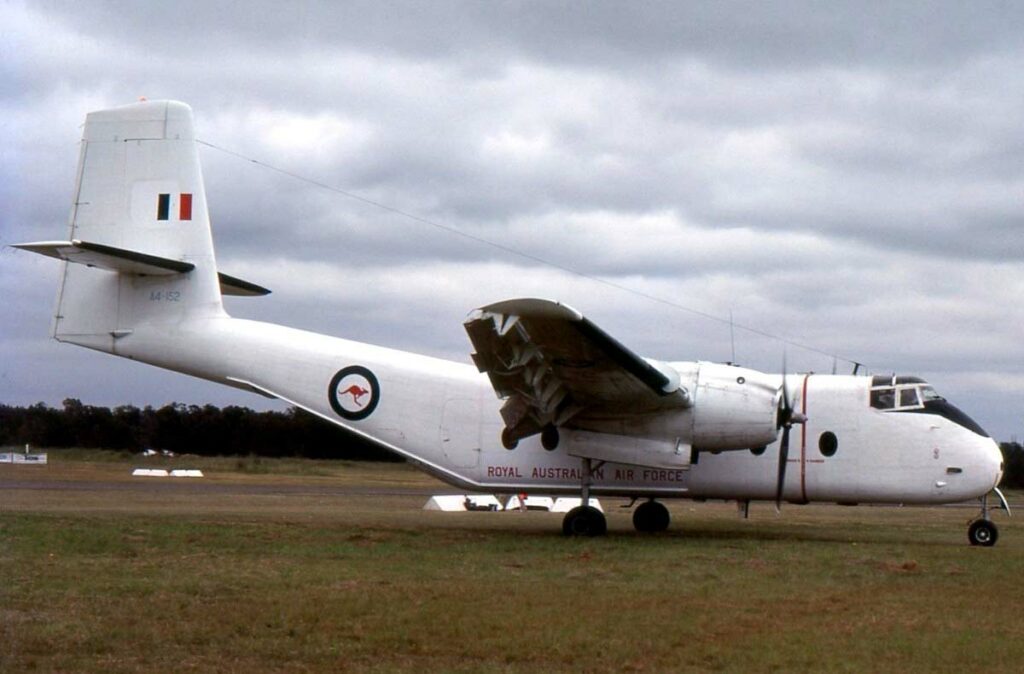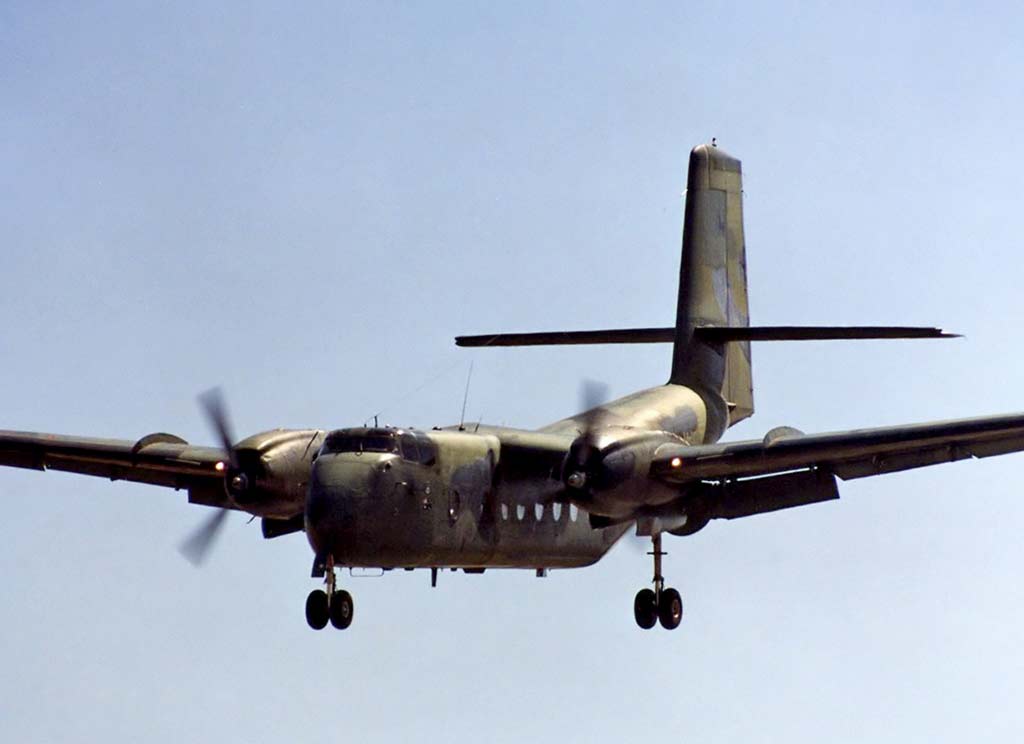A rugged, twin-engine, STOL military transport aircraft designed for cargo and troop movements in challenging terrains.
In brief
The de Havilland Canada DHC-4 Caribou is a military transport aircraft developed in the 1950s, showcasing remarkable Short Takeoff and Landing (STOL) capabilities. It was powered by two Pratt & Whitney R-2000 Twin Wasp radial engines, each generating approximately 1,450 horsepower. With a high-wing design, fixed tricycle undercarriage, and a large rear-loading ramp, the Caribou could operate from unprepared and semi-prepared runways, delivering troops, cargo, and medical evacuation in austere environments. Its maximum takeoff weight was around 28,500 pounds (12,927 kilograms), with a payload capacity of up to 8,000 pounds (3,629 kilograms). The aircraft had a cruising speed of about 216 mph (348 km/h) and a range of 1,032 miles (1,661 kilometers), making it an essential asset for military logistics, particularly in Vietnam where it served extensively.
The de Havilland Canada DHC-4 Caribou holds a distinctive place in aviation history, especially in military transport. Designed to meet the demanding needs of transporting cargo and personnel to and from remote, unprepared airstrips, the Caribou exemplified versatility, durability, and reliability.

History of the Development of the de Havilland Canada DHC-4 Caribou
In the post-World War II era, the need for rugged, versatile transport aircraft became apparent as military and civilian operators alike sought to access increasingly remote areas. The de Havilland Canada company, already renowned for its robust and reliable designs, embarked on a project to fill this niche. The development of the DHC-4 Caribou began in the early 1950s, aimed at creating an aircraft capable of performing short takeoff and landing (STOL) operations while carrying significant payloads.
Launched by de Havilland Canada, the program aimed to produce a versatile aircraft that could fulfill various roles, including troop transport, medevac, and cargo delivery, particularly in areas lacking developed infrastructure. The first flight of the Caribou took place on July 30, 1958, marking the birth of an aircraft that would see widespread use across the globe.
The design and development of the Caribou were driven by the requirements of the era. In the wake of World War II and throughout the Cold War, military operations increasingly demanded rapid, flexible deployment capabilities in varied and often challenging terrains. The Caribou’s ability to operate from short and unprepared runways made it an invaluable asset in these contexts, providing a tactical advantage by enabling forces to mobilize quickly and efficiently.
Though the Caribou did not receive a specific NATO nickname as some aircraft do, its operational prowess and reliability earned it a distinguished reputation among the militaries of numerous countries. It was this capability to perform in diverse environments that underscored the Caribou’s development objectives: to offer unmatched STOL performance, ruggedness, and versatility.
Design of the de Havilland Canada DHC-4 Caribou
The DHC-4 Caribou was designed with a unique blend of features to meet its specified roles. Standing out with its high-wing configuration, the aircraft facilitated excellent visibility and stability, critical for operations in challenging environments. The twin-engine layout, utilizing Pratt & Whitney R-2000 Twin Wasp radial engines, offered a balance of power and reliability, with each engine delivering approximately 1,450 horsepower. This powerplant enabled the Caribou to carry payloads up to 8,000 pounds (3,629 kilograms) over distances up to 1,032 miles (1,661 kilometers).
One of the Caribou’s defining characteristics was its fixed tricycle landing gear, robust enough to withstand the rigors of unprepared runways. The large rear-loading ramp allowed for quick loading and unloading of cargo and personnel, a critical feature for military operations and humanitarian missions alike.
In terms of dimensions, the Caribou had a length of 72 feet 7 inches (22.12 meters), a wingspan of 95 feet 7 inches (29.13 meters), and a height of 31 feet 9 inches (9.68 meters). This size, combined with its STOL capabilities, made it highly adaptable to a wide range of operational scenarios. Despite its many advantages, the Caribou’s performance was a balance between its exceptional capability to access remote areas and the limitations imposed by its payload capacity and speed compared to larger, more modern aircraft. However, its design was a testament to the engineering ingenuity of the era, providing a solution that brought unparalleled access to the most inaccessible regions.
Performance of the de Havilland Canada DHC-4 Caribou
The performance characteristics of the DHC-4 Caribou underscored its role as a versatile and reliable transport aircraft. Powered by two Pratt & Whitney R-2000 Twin Wasp engines, the Caribou could achieve a maximum speed of approximately 216 mph (348 km/h), with a cruising speed of around 173 mph (278 km/h). The aircraft’s range was 1,032 miles (1,661 kilometers), and it could reach a maximum altitude of 24,800 feet (7,560 meters). Its STOL capabilities were particularly impressive, with takeoff and landing distances that allowed it to operate from short and rudimentary airstrips.
Comparatively, the Caribou was not the fastest or the one with the longest range among its contemporaries. However, its ability to operate in austere environments, combined with its payload capacity of up to 8,000 pounds (3,629 kilograms), distinguished it in the realm of tactical transport. This balance of performance attributes made it an essential asset in military operations, especially in regions where infrastructure was minimal or non-existent.
Variants of the de Havilland Canada DHC-4 Caribou
The DHC-4 Caribou was produced in several variants, each tailored to meet specific operational requirements. The primary variant was the DHC-4A, which introduced improvements in payload capacity and performance. Additionally, there were modified versions designed for specific military and civilian operators, each with adjustments to avionics, engine configurations, or cargo handling capabilities. These variants reflected the adaptability of the Caribou design to diverse operational needs, maintaining the core attributes of ruggedness and reliability while accommodating the evolving demands of its users.

Military Use and Combat of the de Havilland Canada DHC-4 Caribou
The military use of the DHC-4 Caribou spans several decades and a variety of operational contexts. Notably, the aircraft saw extensive service during the Vietnam War, where its STOL capabilities were invaluable in transporting troops and supplies to remote outposts. The Caribou’s ability to operate from short and unimproved runways made it a critical asset in the dense jungles and mountainous terrain of Southeast Asia, enabling rapid response and logistical support in the face of challenging conditions.
The Caribou was not typically armed, as its primary role was transport rather than combat. However, its contribution to military operations was significant, facilitating the movement of personnel, equipment, and supplies, and thereby enhancing the operational flexibility and reach of armed forces.
Throughout its service life, the Caribou was compared to other transport aircraft like the Lockheed C-130 Hercules. While the Hercules offered greater speed, range, and payload capacity, the Caribou’s STOL capabilities allowed it to access areas that were otherwise unreachable, highlighting its unique value in specific operational scenarios.
The Caribou has been sold to and used by several countries around the world, further testament to its versatility and reliability. While some nations have phased out the Caribou in favor of more modern aircraft, others continue to operate it in various capacities, underscoring its enduring legacy in military and humanitarian operations.
The de Havilland Canada DHC-4 Caribou represents a remarkable achievement in aviation design and engineering. With its exceptional STOL capabilities, rugged construction, and versatile performance, the Caribou has served as a vital asset in military and humanitarian operations across the globe. Its legacy continues to be felt in the regions it served, a testament to the enduring value of this iconic aircraft.
Back to Transport planes.